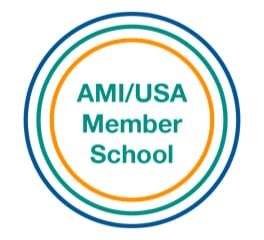Frequently Asked Questions
-
What is the origin of the Montessori method of education?
Montessori education was founded in 1907 by Dr. Maria Montessori. Dr. Montessori based her educational methods on scientific observation of children’s learning processes. Guided by her discovery that children teach themselves, Dr. Montessori designed a “prepared environment” in which children could freely choose from a number of developmentally appropriate activities. Now, nearly a century after Maria Montessori’s first casa dei bambini (“children’s house”) in Rome, Montessori education is found all over the world, spanning ages from birth to adolescence.
-
How do Montessori students learn?
For children six and under, Montessori emphasizes learning through all five senses, not just through listening, watching or reading. Montessori children learn at an individual pace. They may engage in individual or group work with materials that have been introduced to them by a teacher who knows what each child is ready to do. Learning is an exciting process of discovery, leading to increased concentration, motivation, self-discipline and a love of learning.
At age six, Montessori students dive into conducting research, arranging field trips, developing science projects and producing group presentations, art exhibits, theatrical productions and more. There is no limit to what children can create within the realm of this kind of intelligently guided freedom. There is great respect for the choices of the child.
There is no wasted time. Children are eager to assist their classmates and enjoy their work and study. Much learning comes from sharing and inspiring one another instead of competing against each other.
-
I thought Montessori was a Preschool program?
What about gifted children? Montessori is designed to help all children reach their fullest potential at their own unique pace. A classroom whose children have varying abilities is a community in which everyone learns from one another and everyone contributes. Moreover, multi age grouping allows each child to find his or her own pace without feeling “ahead” or “behind” in relation to peers.
-
When was Fort Collins Montessori School (FCMS) founded?
Fort Collins Montessori School opened its doors in August 2014. For seven years, Fort Collins Montessori School served students in rented spaces in Fort Collins. In 2020, the school purchased property and completed construction of its new campus at 1109 W Harmony Road.
-
How does Fort Collins Montessori School contribute to the local community?
Montessori children thrive academically, socially, cognitively and emotionally, making them engaged citizens. The focus on nature and service learning encourages students to be lifelong stewards of the environment and community.
-
What training do FCMS Montessori teachers have?
FCMS teachers are Association Montessori Internationale (AMI) trained for their level of Montessori teaching. This training is in addition to their Bachelor’s or Master’s degree(s). AMI training takes a full academic year to complete and requires several weeks of additional classroom observation, student teaching and passing an exam on all aspects of Montessori theory and pedagogy.
-
How is Fort Collins Montessori School funded?
Poudre School District charter schools, including FCMS, receive per-pupil funding from the district. However, charter schools receive far less support from the district for facilities and charter schools must make up the funding difference. FCMS is engaged in a fundraising push to realize its goal of a facility of its own. If you are interested in sharing your time, resources or a financial gift with FCMS, please call (970) 631-8612 or donate here. All financial gifts, no matter the size, are investments in the future of FCMS and the greater Fort Collins community.
-
What are the long-term benefits of a Montessori education?
Montessori children have advanced social cognition from having been a part of a community that cares for both its physical and social environment. “Freedom within limits” promotes creativity and self-discipline—and as neuropsychologist Steven J. Hughes puts it, Montessori students are simply “good at doing things.”
-
What does a Montessori class look like?
Montessori commonly groups 25 to 30 children in one class. It is typical for each class to be guided by one teacher and one assistant. Montessori teachers, also called Guides, do not teach in the traditional sense of the word. Instead, they guide, observe and create an environment of calm, order and joy. They know when to intervene and above all, they know when to step back. In a Montessori classroom, larger class sizes encourage independence and resourcefulness in the child. Children seek out peers to work with, encouraging strong community building at a very young age. Furthermore, grouping children in larger, multi-age classrooms—where two-thirds of the children normally return each year—promotes continuity and the development of a stable learning community.
-
How do teachers engage with each child in the classroom?
The teacher’s primary role in a Montessori classroom is to prepare and maintain the physical, intellectual, social and emotional environment in which the children work. A key aspect of this is the provision of developmentally appropriate learning activities to meet the needs and interests of each child in the class.
Montessori teachers may present lessons individually or in small groups and limit lessons to brief and clear presentations. The goal is to provide the child with just enough to spark their interest and to then want to continue to work on their own with the learning materials.
Montessori teachers closely monitor student progress. Because a teacher typically works with each child for two to three years, they get to know their students’ strengths, interests and personalities. Montessori teachers often use a child’s interests to enrich the curriculum and provide alternate avenues for accomplishment and success.
-
Is there anyone I might know who went to a Montessori school?
Montessori students often go on to become great thinkers. Notable Montessori students include Google founders Larry Page and Sergei Brin, actor George Clooney, Amazon’s Jeff Bezos, humanitarian HM Queen Noor of Jordan, singers Taylor Swift and Beyoncé Knowles, Wikipedia founder Jimmy Wales, chef Julia Childs, cellist Yo-Yo Ma, Sims creator Will Wright, author Helen Keller and rapper Sean “P. Diddy” Combs.
-
Are all Montessori schools alike?
No. Montessori schools vary widely because the name “Montessori” is in the public domain. This means that anyone wishing to use the name “Montessori” for their school may do so. The best way to ensure that a program is faithfully incorporating the Montessori approach as developed by Maria Montessori is to ask if the school is affiliated with Association Montessori Internationale (AMI).
-
What do children do in a Montessori program?
There are different integrated areas of learning in a Montessori classroom; practical life skills, sensorial development, language, mathematics, history, science and cultural studies (geography, art, music). In addition to the available materials in each area, children might also take time during the day to sing songs, read a story or enjoy nature.
Children are provided with both individual and group lessons in each area of learning. Emphasis is placed on helping children choose pursuits that are of interest to them, thus supporting the child’s natural curiosity and desire to learn. At the Elementary Level (6-12 years), expect to see children working together on projects. Collaboration at this age helps the child to become socially adapted and aware of the needs of others.
What you will not see in a genuine Montessori program are systems of rewards and punishments to promote work or control behavior. There will be no lost recess, gold stars or grades. In a Montessori classroom, children are engaged, active and respectful because they are internally motivated.
-
What is the advantage of having a three-year age span in the classroom?
Children have a wide range of experiences, skills, abilities and interests. A three-year age span in the classroom allows children the opportunity to use a wide range of engaging materials that keep them challenged. As a child’s interests change and abilities grow, the range of available materials allows the child to move from one level of complexity to another.
Additionally, children have the opportunity to be learners and teachers simultaneously. This allows a child to experience the joy of providing leadership to those who are younger and the satisfaction of receiving useful assistance from those who are older or more skilled. It is a win-win for all the children.
-
How is discipline handled in a Montessori classroom?
The development of self-discipline is encouraged and valued. By maintaining a prepared environment that encourages exploration, creativity and choice, the child learns self-control and problem-solving skills that foster independence and responsibility. In this setting, discipline is viewed as a maturation process that evolves, supported by guidance from the teacher. With prudent assistance, children become comfortable and equipped to accept the consequences of their own behavior. Skilled AMI-trained teachers use Montessori materials and activities to promote a classroom atmosphere that reinforces personal discipline and harmony by offering each child the opportunity to gain a sense of direction, confidence, cooperation and self-control.
-
Why the non-competitive atmosphere in Montessori when we live in such a competitive world?
In a Montessori program, children are on their own journey and at their own pace toward maturity, acquisition of skills and incorporation of knowledge. The emphasis is on assisting and supporting children to develop and learn based on their interests, desires and timing. Attention is also paid to promoting collaborative social and educational relationships that enhance learning through shared ideas and insights.
Using systems of rewards in the classroom distracts a child’s journey by intentionally directing their attention to the progress of other children. Studies have shown that competition does little to build confidence or strengthen internal motivation and self-direction over the long-term. There are situations where competitive activities can move children to greater efforts and improved skills, but as Maria Montessori put it, “the prize and the punishment are incentives towards unnatural or forced effort and therefore we certainly cannot speak of the natural development of the child in connection with them.”
-
Do children have difficulty transitioning to a public school after going to a Montessori school?
Moving from a Montessori school to another school setting is an issue often raised by parents and family members. Happily, the habits and skills a child develops in a Montessori class last a lifetime and stand a child in good stead no matter where they go.
Montessori children tend to be adaptable, working well alone or with a group. They have solid decision-making skills, practical problem solving abilities and generally manage their time well. Since children in a Montessori classroom are also encouraged to share ideas and discuss their work, fitting into new situations is made easier thanks to good communication skills.
-
How do I apply to enroll my child?
Our application process is quick and easy, please find detailed answeres on our Enrollment page.
-
What are my child’s chances of getting in to FCMS?
Most available openings at FCMS are in Preschool and Kindergarten. Following the Open Enrollment period, if there are more new enrollment requests than there are spots available, a lottery will be held. This lottery determines which children will receive an offer for enrollment and which children will be wait listed and offered spots as they open up.
Though there is a wait list, occasionally slots open up in our Elementary Program. Please contact the School Office for information.
-
Why does FCMS fundraise?
As a public charter school, the only monies our school district is required to provide our school are funds for the basic necessities of teaching. This does not include funding for a facility, teacher training, physical education or low-income tuition/fee assistance. Historically, the State has provided 20% less per charter student than what a typical public school receives for their students. This is about $1,400 less per student. On top of this, the State of Colorado funds public schools over $2,700 less per student compared to the national average. This totals over $4,000 per year per student, less than the average public school in the average state. Furthermore, it is eye-opening when we consider that the average tuition for a private Montessori school in Colorado is $20,000 per year per student.
-
Are FCMS teachers required to take annual enrichment classes like other PSD teachers?
Yes. However, the cost of these classes is not covered by school district funding.
-
Where can I find a calendar of days off?
See the FCMS School Calendar.
-
Allergens? Are they the same for each class and campus?
Montessori’s discipline and order gives it an advantage for those students with allergies. FCMS is a peanut-free school. Additionally each teacher is provided a list at the beginning of the year of known allergies in their class. If children bring these allergens to school, they must request an allergen card, which alerts the teacher.
-
Do FCMS students take standardized tests?
Yes, children in public Montessori programs are required to meet state regulations. It is the responsibility of our teachers to ensure students are prepared to take these tests.
Families may opt their child out of standardized testing, but testing is a way to monitor the child’s progress and ensure the school is fulfilling its requirements. You may contact the Elementary School Office or our Head of School to discuss any questions you may have.
-
When do the children interact with each other?
Montessori children interact with each other throughout the day. Students often partner or group-up for collaborative work. When working independently, children often interact with one another in passing, when asking a fellow classmate for assistance, or when observing another child’s work.
-
Why is there only one 30-minute recess?
A 30-minutes recess allows the children to complete two three-hour work periods. Work periods consist of regular movement around the classroom and interaction with others. Add this to the 30-minute formal recess and children cycle between regular movement, rest and physical exercise throughout the day.
-
Why can’t I walk my child to the classroom?
When the caregiver says goodbye at the door, it provides the child a confidence-building start to the day. The child is choosing to go to school and you, the caregiver, are exhibiting confidence in your child. Allowing them to walk into school by themselves helps children work through their own trepidations and establish the pattern of putting their things away and beginning their work routine. This repetition sets the child up for later success in work, but also in confidence that they can choose to be self-sufficient beings.
-
What is a charter school?
Charter schools are unique public schools that are allowed the freedom to be more innovative while being held accountable for advancing student achievement.
- Charter schools are public schools.
- Charter schools do not charge tuition for full-day kindergarten through high school.
- Charter schools do not have special entrance requirements.
- Charter schools are bound by federal and state public school laws.
- Charter schools do not discriminate.
- Charter schools accept students with disabilities and/or special needs.
- Charter schools do not teach religion.
-
Why aren’t 2- or 3-day a week Preschool classes offered? Why are full days, 5 days a week recommended for Pre-K?
Montessori is difficult to implement when not fortified daily. A consistent routine establishes expectations of work and social interaction. With regular interaction with the teachers and the other children, the magic really happens. Having a child attend Montessori infrequently cannot fully bring about the benefits of Montessori.
-
How can I learn more about Montessori before my child starts?
Peruse the Montessori Research page—it is chockfull of articles and studies. Other great resources include Association Montessori Internationale and the Colorado Montessori Association.
-
Who do I make the Application Fee check out to?
Please make the checks payable to Fort Collins Montessori School and write Application Fee in the subject line.
-
Do I have to fill out the school of choice form?
Yes, when you apply, this form needs to be filled out. Enrollment information and forms can be found here.
-
What does the Parent Volunteer Committee do?
The Parent Volunteer Committee (PVC) is a standing sub-committee of the FCMS School Board and is comprised of caregiver volunteers. Primary PVC functions include coordinating parent volunteers, raising funds to support initiatives related to staff appreciation and community building and supporting strategic initiatives set by the Board and Staff.
-
What other committees exist?
There are a number of committees working on various initiatives. Please see the Committees page.
-
How do I report attendance?
If your child is sick prior to the school day, please send an email to your child’s teacher as well as attendance@focomontessori.org telling us who will be absent along with a brief description of what is going on. We ask this in the event there is a communicable issue that needs to be communicated to required parents/classes or the school district if necessary.
If your child begins feeling ill during the school day, they should to tell their teacher and calls will made to the numbers on file. If your child has not vomited nor ran a fever over 100F, then the child may wait it out. However, if these symptoms present themselves, a guardian will need to come pick up the child. A child is not permitted to return to school until he/she has been fever/diarrhea/vomit free for 24 hours, without medicine.
-
Does FCMS provide lunches?
No. FCMS has some financial assistance available for qualifying low-income families, however due to state health department licensing requirements the preparation of and/or serving of food at our current facilities is not allowed.
-
May I volunteer?
Yes! There are many ways to share your time. Classrooms have ongoing needs that you can help meet. Or how about volunteering with a committee or for a school event? Complete our volunteer training and agree to a background check and you may be able to drive Elementary students on goings-out or help at the front desk or on the playground. Visit the Volunteer page for more details.
-
Do I have to renew my volunteer information each year?
No, the Colorado Bureau of Investigation will notify the school if any renewals are required. However, the school may need to know that you are available for the new school year.
Please let us know if you have any other questions by calling (970) 631-8612 or emailing office@focomontessori.org.
-
What does pick-up and drop-off look like?
Families are provided unique driveline codes to be displayed in the front right side of your vehicle to assist with both drop-off and pick-up. Staff members will be present to support children. All traffic signs must be followed while on campus and while exiting to ensure everyone’s safety. Please remember to respect our neighbors when entering and leaving our campus by driving slowly and carefully.
- Before Care 7:00-7:59
- Drop-off times all children (not in Before or After Care) 8:00-8:30
- Pick-up times all children (not in Before or After Care) 3:00-3:30
- After Care 3:30-6:00
PROCARE APP CHECK-IN
- Please download the Procare app (Android or Apple)
- We have set up Geo-Fencing for our campus so you can sign-in without having to touch another device. Simply open your app on your device and sign-in when you come into range of our Geo-Fence. If you do not have the capability for this service, we will also have iPads with scannable QR codes to assist you with contactless sign-in. Please contact the office if you are unable to use either of these services so we can help find an alternative solution.
DRIVE THROUGH PROCESS
- For families coming in off of East Harmony, you will turn left into the property and drive through the parking lot. Following the direction of traffic to enter into the drop-off lane (far right lane when facing the East side of the building.) Once in the lane, a staff member will greet you and begin our check-in process. Once your child has been checked-in, you will follow traffic to exit campus onto South Shields.
- Families coming in off of North Shields, you will turn left at the turn pocket on North Shields following all traffic signs. Once on campus, you will then follow the through signs to the right-hand side of the drive ellipse in order to enter the Drop Off Lane on the west side of the ellipse, right in front of the building.
- Children may only be dropped off while in the Drop Off Lane. If you or your child has forgotten something, you may re-enter the drive lane by continuing around the drive ellipse to re-enter the Drop Off Lane, no exceptions. No one is to leave their vehicle while in any of the through lanes.
WALKING/BIKING FAMILIES
- Biking to School: If you are riding your bike to school and will want to store your bike on campus during the day, our bike rack is located on the Northwest corner of the building right next to the trash enclosure. Please make sure to secure the bike in the rack and remove any belongings that may be misplaced or mistakenly taken. Then proceed to the walking process.
- Walking to School: If you are walking to school, please enter the campus via one of the sidewalks on East Harmony road and proceed to the East front of the building. There is a cross walk across the parking lot that will allow you entrance to the front of the building. We will have cones set out to mark locations for walker/bike riders to wait to be checked in.
CHECK-IN PROCESS
- Caregivers will be responsible for opening doors and helping children in and out of their vehicle.
- Staff members will be stationed throughout the building and outside to escort children to their classrooms.
PICK-UP PROCESS
*Please remain in your vehicle until you are ready to buckle your child’s seat belt.
- Parents will display their vehicle tag with the unique driveline code on the right side of the vehicle to assist with dismissal.
- When you are in the drop-off lane and your tag is displayed, a staff member will enter your code notifying your child’s teacher to bring them to the pick-up zone.
- Please sign out your child in the Procare app.
- The driver will be responsible for loading and buckling your child.
- When exiting the drop-off lane, please be aware of traffic in the through lane to avoid crashes.
- Exit the campus via a right hand only turn onto South Shields or parking lot users exit via the right hand only turn onto East Harmony.
-
How do I learn more about Gifted and Talented at FCMS






